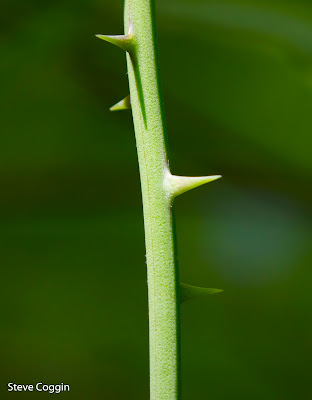 |
| Thorns of Trifoliate Orange (Poncirus trifoliata). Rowan County, North Carolina. |
It happens all the time. Hiking through a field, I get pulled up short by a Blackberry cane and come away with a bloody scrape. Plants that grab and slash are said to be armed and botanists have precise terms for these armaments; thorns, spines and prickles.
 |
| Wounds from Blackberry (Rubus sp.) prickles. Rowan County, North Carolina. |
Thorns are modified branches that come to a point. These sharp structures defend the plant from the attention of herbivores. Sweet Acacia, Vachellia faresiana, is a shrub in the bean family, Fabaceae. It has a world-wide distribution and in the US it grows in the west and Florida. We found Sweet Acacia flowering in the deserts of southeastern Arizona. The thorns are arranged along the stem and protect the delicate leaves and bright yellow flower clusters.
 |
| Sweet Acacia (Vachellia faresiana). Cochise County, Arizona. |
 |
| Giant thorns of Honey Locust (Gleditsia triacanthos). Rowan County, North Carolina. |
Another small tree with impressive thorns is Trifoliate Orange (Poncirus trifoliata). Trifoliate Orange is a close relative of oranges and lemons. It is native to northern China and Korea and has been naturalized in many countries. Trifoliate Orange is cold tolerant and is used as root stock to graft species of Citrus. Because of its thorns Trifoliate Orange is planted as a natural fence.
 |
| Leaves and thorns of Trifoliate Orange. Rowan County, North Carolina. |
Members of the family Cactaceae have spines. Cacti have reduced their leaves through evolutionary time to spines. This change lowered the leaf surface area and cut down on water loss from the plant. The spines have lost their photosynthetic ability and the cactus stem has taken on that function. The stems also store water, and the spines protect that precious resource from thirsty desert creatures.
 |
| The aptly named Fishhook Barrel Cactus (Ferocactus wislizeni) has hooked spines.. Portal, Arizona. |
 |
| Prickly Pear Cactus (Opuntia ficus-indica) with spines. Arizona-Sonora Desert Museum, Arizona. |
 |
| Saguaro (Carnegiea gigantea) with rows of spines. Arizona-Sonora Desert Museum, Arizona. |
 |
| Blackberry (Rubus sp.) armed with prickles. Rowan County, North Carolina. |
 |
| Prickles on Multiflora Rose (Rosa multiflora). Rowan County, North Carolina. |
 |
| Greenbriar (Smilax sp.) showing its prickles. Rowan County, North Carolina. |
You often hear people talk about thorns of the rose. This combination of beauty and pain have made roses a powerful symbol of love over the centuries. But roses have prickles, not thorns. This misuse of terms is common. Thorn and spine are used interchangeably by most people and prickles are hardly mentioned at all. But to botanists, thorns, spines and prickles have a precise meaning that the rest of the world ignores, at its peril.
No comments:
Post a Comment